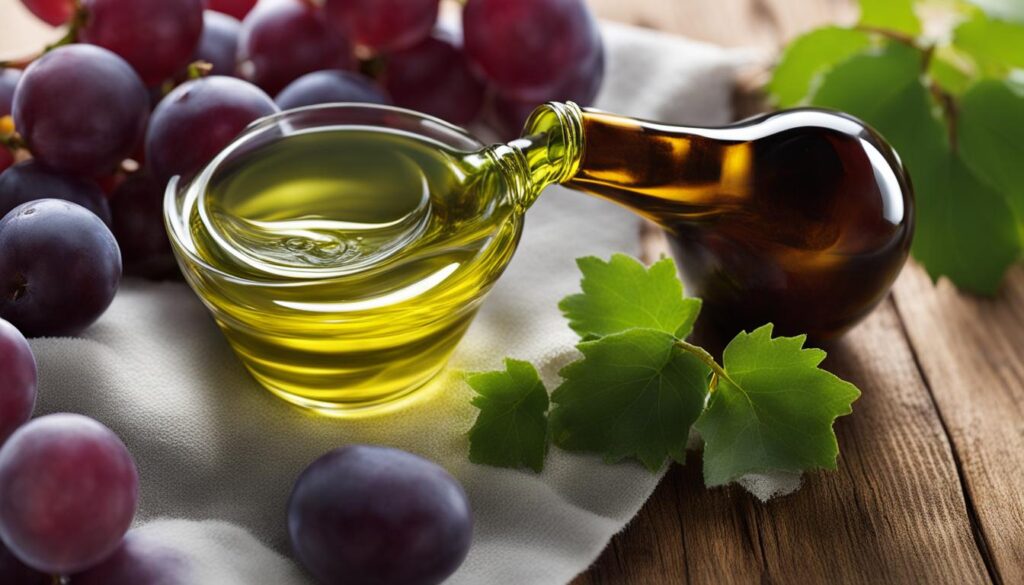Skincare Properties of Grapeseed Oil
Grapeseed oil is a powerhouse when it comes to skincare properties. Not only does it have the ability to aid in wound healing, but it is also packed with antioxidants, polyunsaturated fatty acids, and hydration benefits.
One of the key components of grapeseed oil that makes it so effective for skincare is its abundance of antioxidants. These antioxidants, such as phenolic compounds, resveratrol, and vitamin E, work together to neutralize free radicals and protect the skin from damage. This not only helps to reduce cell damage but also promotes overall skin healing.
In addition to antioxidants, grapeseed oil is rich in polyunsaturated fatty acids. These essential fatty acids are vital for maintaining the health and appearance of the skin. They provide essential nutrients that nourish the skin, keeping it looking hydrated and radiant.
When it comes to hydration, grapeseed oil is a game-changer. Unlike other oils that may leave a greasy residue, grapeseed oil is easily absorbed by the skin, locking in moisture without the heavy feel. This makes it ideal for all skin types, including those with oily or acne-prone skin.
Whether you’re looking to heal wounds, protect your skin from damage, or simply keep it hydrated and nourished, grapeseed oil is a fantastic addition to your skincare routine.
Texture and Lubrication
When it comes to massage therapy, the texture of the oil used can greatly influence the overall experience. Grapeseed oil, with its exceptional texture, offers numerous advantages for both the therapist and the client.
First and foremost, grapeseed oil has a light and non-greasy consistency, making it easy to apply and ensuring a smooth gliding sensation over the skin. This allows for effortless movements and precise control during the massage, enhancing the therapist’s technique and ensuring a satisfying experience for the client.
Moreover, grapeseed oil provides long-lasting lubrication, which is crucial for a seamless massage session. The oil’s ability to reduce friction between the hands and the skin enables fluid and uninterrupted movements, minimizing any discomfort or irritation that may arise from dry or tugging sensations.
Thanks to its light texture, grapeseed oil doesn’t leave a heavy or sticky residue on the skin, promoting a sense of comfort and relaxation throughout the massage. This ensures that the focus remains on the therapeutic benefits of the treatment, allowing the client to fully unwind and enjoy the experience.
Overall, grapeseed oil’s excellent texture and long-lasting lubrication make it an ideal choice for massage therapy. Its lightweight nature, combined with its nourishing properties, provides a soothing and pleasurable massage experience for both the therapist and the client.
Client Testimonial:
“The grapeseed oil used during my massage had the perfect texture. It felt light and smooth on my skin, allowing the therapist’s hands to glide effortlessly. I loved how it provided long-lasting lubrication, making the massage incredibly relaxing. I highly recommend grapeseed oil for anyone looking for a truly indulgent massage experience!”
| Benefits of Grapeseed Oil | Texture and Lubrication |
|---|---|
| Lightweight and non-greasy consistency | ✔ |
| Easy application and smooth gliding | ✔ |
| Long-lasting lubrication | ✔ |
| No heavy or sticky residue | ✔ |

Skin Compatibility
One of the key advantages of grapeseed oil is its exceptional compatibility with all skin types. Its gentle and non-irritating nature makes it an ideal choice, particularly for individuals with sensitive skin. Whether the client has normal, dry, oily, or sensitive skin, grapeseed oil can effectively nourish and moisturize without causing any adverse reactions.
Grapeseed oil is known for its neutral scent, minimizing the risk of scent clash with essential oils used in aromatherapy. This ensures a harmonious and pleasant experience during the massage.
Its lightweight and non-greasy texture makes grapeseed oil a preferred option for those with sensitive skin. The oil absorbs easily and leaves the skin feeling soft and hydrated without any residue.
Nourishment for Sensitive Skin
Grapeseed oil is rich in antioxidants and essential fatty acids, providing deep nourishment for the skin. Its antioxidant properties help to neutralize free radicals, reducing cell damage and promoting healthy skin.
“Grapeseed oil is a versatile option that works wonders for my clients with sensitive skin,” says Jennifer Thompson, a registered massage therapist with over a decade of experience. “The lightweight texture and natural nourishing properties make it suitable even for the most delicate skin.”
“I have been using grapeseed oil in my massage practice for years. It’s a fantastic choice for clients who have sensitive skin. The oil is gentle, moisturizing, and doesn’t cause any irritation. I have received positive feedback from clients who appreciate how their skin feels after a massage with grapeseed oil.”
Whether you are a massage therapist or someone seeking a relaxing massage, grapeseed oil’s compatibility with sensitive skin makes it an excellent option for promoting healthy and nourished skin.
Comparison of Key Oil Compatibilities
| Oil Type | Sensitive Skin Compatibility |
|---|---|
| Grapeseed Oil | ✅ |
| Coconut Oil | ❌ |
| Almond Oil | ✅ |
| Olive Oil | ❌ |
Note: The table above represents a general overview of oil compatibilities with sensitive skin. It is essential to consider individual reactions and consult with a healthcare professional if you have specific concerns.
Eco-Friendly Production
In the production of grapeseed oil, sustainability and minimizing the environmental impact are key considerations. By utilizing the by-products of the wine-making industry, grapeseed oil offers a sustainable solution that reduces waste and maximizes resource efficiency.
Grapeseed oil is extracted from grape seeds that would otherwise be discarded. These seeds are a valuable source of oil, rich in antioxidants and beneficial compounds. By repurposing these seeds, grapeseed oil production helps to reduce waste and minimize the environmental footprint of the wine industry.
The production of grapeseed oil exemplifies the concept of sustainability by turning a potential waste product into a valuable resource.
By choosing grapeseed oil for massage therapy, practitioners support eco-friendly practices. The decision to use a natural oil derived from waste materials contributes to a more sustainable future.
Furthermore, grapeseed oil production aligns with the principles of resource efficiency. The oil extraction process optimizes the use of every part of the grape, ensuring that no valuable component goes to waste. This efficient utilization of resources further minimizes the environmental impact of grapeseed oil production.
Environmental Benefits
The environmental benefits of grapeseed oil production are twofold. Firstly, it reduces waste in the wine-making process by repurposing grape seeds that would otherwise be discarded. Secondly, it contributes to resource efficiency by utilizing every part of the grape in the oil extraction process.
| Environmental Benefits of Grapeseed Oil Production |
|---|
| Reduces waste in the wine-making industry |
| Utilizes by-products that would otherwise be discarded |
| Maximizes resource efficiency |
| Optimizes the use of every part of the grape |
By embracing grapeseed oil as a sustainable choice, the massage industry can contribute to a greener and more environmentally conscious future. The use of this eco-friendly oil not only benefits the planet, but it also aligns with the increasing demand for sustainable and ethically sourced products.

Professional Applications
Grapeseed oil is a valuable asset in the field of professional massage therapy. Its unique properties make it an ideal choice for a wide range of massage techniques and modalities. With its light and non-greasy texture, grapeseed oil allows for smooth gliding and effortless application, enhancing the overall massage experience.
Massage therapists can confidently utilize grapeseed oil in their practice, knowing that it is suitable for clients with different preferences and needs. Whether it’s a deep tissue massage, aromatherapy session, or a relaxing Swedish massage, grapeseed oil adapts easily to various techniques, providing the desired level of lubrication and glide.
Blending grapeseed oil with essential oils can further enhance the therapeutic benefits of massage therapy. By customizing the oil with aromatic extracts, massage therapists can create a tailored experience that promotes relaxation, rejuvenation, or specific wellness objectives.
Moreover, grapeseed oil offers excellent skin compatibility, making it suitable for clients with sensitive skin. Its gentle formula ensures a comfortable, irritation-free massage from start to finish. With grapeseed oil, massage therapists can cater to a broader client base, considering the different skin sensitivities and preferences of each individual.
Benefits of Grapeseed Oil for Professional Massages:
- Smooth gliding and effortless application
- Adaptable to various massage techniques and modalities
- Compatible with different skin types, including sensitive skin
- Customizable by blending with essential oils for aromatic benefits

| Grapeseed Oil for Professional Massages | Grapeseed Oil for Massage Therapy |
|---|---|
| Smooth gliding and effortless application | Lubricates the skin for optimal massage movements |
| Adaptable to various massage techniques and modalities | Suitable for deep tissue, aromatherapy, and relaxation massages |
| Compatible with different skin types, including sensitive skin | Gentle on the skin, minimizing the risk of irritation |
| Customizable by blending with essential oils for aromatic benefits | Enhances the massage experience with personalized scents and therapeutic effects |
Conclusion
Grapeseed oil offers numerous benefits for massage therapy. With its impressive skincare properties, including wound healing and antioxidant protection, grapeseed oil is a valuable choice for nourishing and hydrating the skin during a massage. The oil’s light texture allows for smooth application and long-lasting lubrication, making it ideal for body massages.
Not only does grapeseed oil benefit the skin, but it is also compatible with all skin types, including sensitive skin. Its neutral scent ensures a pleasant experience without clashing with any aromatherapy oils used during the massage. Whether clients have normal, dry, oily, or sensitive skin, grapeseed oil can effectively moisturize and nourish, leaving their skin feeling revitalized.
Furthermore, incorporating grapeseed oil into massage therapy promotes sustainability. The oil is produced from the by-products of the wine-making industry, contributing to a reduced environmental impact. By utilizing grape seeds that would otherwise go to waste, grapeseed oil supports eco-friendly practices and encourages a more sustainable future.
In summary, grapeseed oil is a versatile and soothing choice for professional massages. Its skincare properties, light texture, compatibility with all skin types, and eco-friendly production make it a go-to oil for massage therapists. By incorporating grapeseed oil into their practice, therapists can enhance the massage experience and provide clients with the nourishing and revitalizing benefits that grapeseed oil has to offer.
FAQ
What are the skincare properties of grapeseed oil?
Grapeseed oil has impressive skincare properties, including the ability to aid in wound healing. It contains a flavonoid compound called proanthocyanidins, which is a strong antioxidant that promotes skin healing and reduces cell damage. The high amounts of antioxidants, such as phenolic compounds, resveratrol, and vitamin E, neutralize free radicals and protect the skin from damage. Grapeseed oil also has a high concentration of polyunsaturated fatty acids, which improve the appearance and health of the skin by providing essential nutrients. Furthermore, grapeseed oil helps to keep the skin hydrated by locking in moisture without leaving a greasy residue.
What is the texture and lubrication like with grapeseed oil?
Grapeseed oil has an excellent texture for massage therapy. It is light and non-greasy, allowing for easy application and smooth gliding over the skin. The oil provides long-lasting lubrication, reducing friction during the massage and enhancing the therapist’s movements. The light texture of grapeseed oil ensures that it doesn’t feel heavy on the skin, allowing for a comfortable and enjoyable massage experience.
Is grapeseed oil compatible with all skin types?
One of the key advantages of grapeseed oil is its suitability for all skin types. It is gentle and non-irritating, making it ideal for individuals with sensitive skin. Grapeseed oil has a neutral scent, minimizing the risk of any scent clash with essential oils used in aromatherapy. Whether the client has normal, dry, oily, or sensitive skin, grapeseed oil can effectively nourish and moisturize the skin without causing any adverse reactions.
How is grapeseed oil produced and is it eco-friendly?
Grapeseed oil is produced from the by-products of the wine-making industry, making it a sustainable choice. The oil is made from grape seeds that would otherwise be waste, reducing environmental impact. By utilizing these by-products, grapeseed oil helps minimize waste and maximize resource efficiency. Choosing grapeseed oil for massage supports eco-friendly practices and contributes to a more sustainable future.
How can grapeseed oil be used in professional massage therapy?
Grapeseed oil is a versatile oil that is widely used in professional massage therapy. It is suitable for various massage techniques and can be easily incorporated into different massage modalities. The light and non-greasy texture of grapeseed oil allows for smooth gliding and effortless application. Massage therapists can confidently use grapeseed oil for a wide range of clients and customize it by blending with essential oils for added aromatherapy benefits.
What are the benefits of using grapeseed oil for massage?
Grapeseed oil offers numerous benefits for massage therapy. Its skincare properties, such as wound healing and antioxidant protection, make it an excellent choice for nourishing and hydrating the skin during a massage. The light texture, neutral scent, and compatibility with all skin types make grapeseed oil a versatile and soothing oil for professional massages. Additionally, the sustainable production of grapeseed oil aligns with eco-friendly practices. Incorporating grapeseed oil into massage therapy can enhance the massage experience and provide clients with the skin-nourishing benefits they seek.






